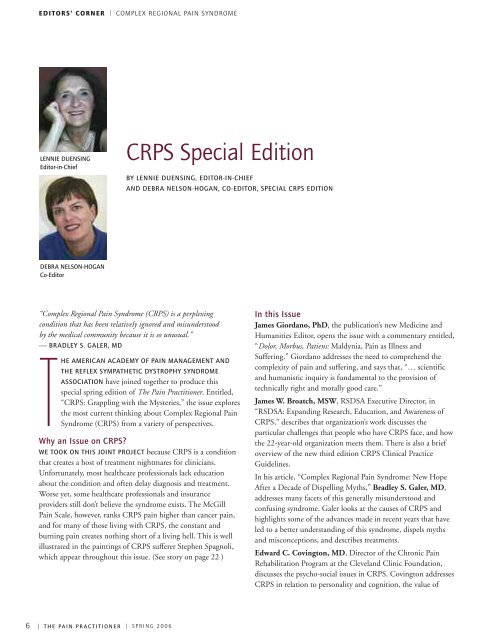printer-friendly version (PDF) - Reflex Sympathetic Dystrophy ...
printer-friendly version (PDF) - Reflex Sympathetic Dystrophy ...
printer-friendly version (PDF) - Reflex Sympathetic Dystrophy ...
You also want an ePaper? Increase the reach of your titles
YUMPU automatically turns print PDFs into web optimized ePapers that Google loves.
EDITORS’ CORNER | COMPLEX REGIONAL PAIN SYNDROME<br />
LENNIE DUENSING<br />
Editor-in-Chief<br />
CRPS Special Edition<br />
BY LENNIE DUENSING, EDITOR-IN-CHIEF<br />
AND DEBRA NELSON-HOGAN, CO-EDITOR, SPECIAL CRPS EDITION<br />
DEBRA NELSON-HOGAN<br />
Co-Editor<br />
“Complex Regional Pain Syndrome (CRPS) is a perplexing<br />
condition that has been relatively ignored and misunderstood<br />
by the medical community because it is so unusual.”<br />
— BRADLEY S. GALER, MD<br />
THE AMERICAN ACADEMY OF PAIN MANAGEMENT AND<br />
THE REFLEX SYMPATHETIC DYSTROPHY SYNDROME<br />
ASSOCIATION have joined together to produce this<br />
special spring edition of The Pain Practitioner. Entitled,<br />
“CRPS: Grappling with the Mysteries,” the issue explores<br />
the most current thinking about Complex Regional Pain<br />
Syndrome (CRPS) from a variety of perspectives.<br />
Why an Issue on CRPS?<br />
WE TOOK ON THIS JOINT PROJECT because CRPS is a condition<br />
that creates a host of treatment nightmares for clinicians.<br />
Unfortunately, most healthcare professionals lack education<br />
about the condition and often delay diagnosis and treatment.<br />
Worse yet, some healthcare professionals and insurance<br />
providers still don’t believe the syndrome exists. The McGill<br />
Pain Scale, however, ranks CRPS pain higher than cancer pain,<br />
and for many of those living with CRPS, the constant and<br />
burning pain creates nothing short of a living hell. This is well<br />
illustrated in the paintings of CRPS sufferer Stephen Spagnoli,<br />
which appear throughout this issue. (See story on page 22 )<br />
In this Issue<br />
James Giordano, PhD, the publication’s new Medicine and<br />
Humanities Editor, opens the issue with a commentary entitled,<br />
“Dolor, Morbus, Patiens: Maldynia, Pain as Illness and<br />
Suffering.” Giordano addresses the need to comprehend the<br />
complexity of pain and suffering, and says that, “… scientific<br />
and humanistic inquiry is fundamental to the provision of<br />
technically right and morally good care.”<br />
James W. Broatch, MSW, RSDSA Executive Director, in<br />
“RSDSA: Expanding Research, Education, and Awareness of<br />
CRPS,” describes that organization’s work discusses the<br />
particular challenges that people who have CRPS face, and how<br />
the 22-year-old organization meets them. There is also a brief<br />
overview of the new third edition CRPS Clinical Practice<br />
Guidelines.<br />
In his article, “Complex Regional Pain Syndrome: New Hope<br />
After a Decade of Dispelling Myths,” Bradley S. Galer, MD,<br />
addresses many facets of this generally misunderstood and<br />
confusing syndrome. Galer looks at the causes of CRPS and<br />
highlights some of the advances made in recent years that have<br />
led to a better understanding of this syndrome, dispels myths<br />
and misconceptions, and describes treatments.<br />
Edward C. Covington, MD, Director of the Chronic Pain<br />
Rehabilitation Program at the Cleveland Clinic Foundation,<br />
discusses the psycho-social issues in CRPS. Covington addresses<br />
CRPS in relation to personality and cognition, the value of<br />
6 | T H E PA I N P R A C T I T I O N E R | S P R I N G 2 0 0 6
















